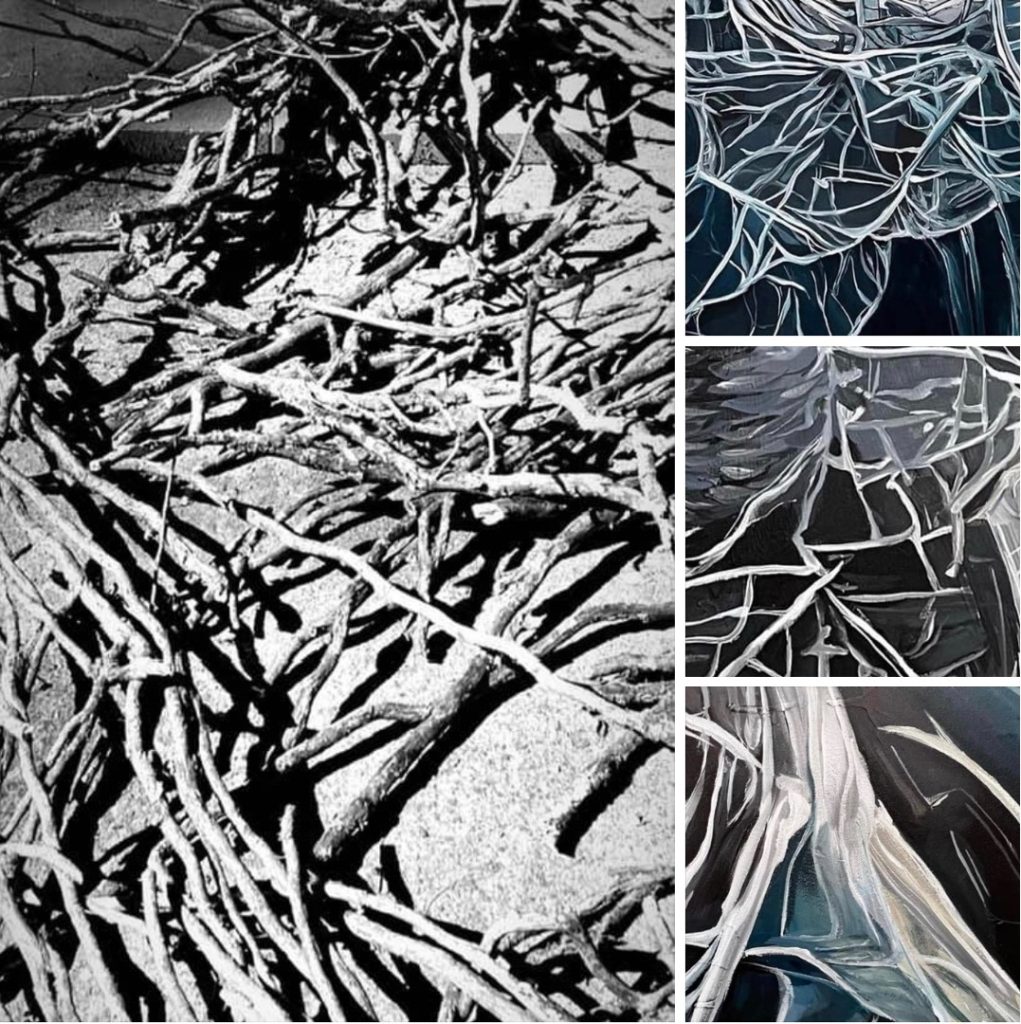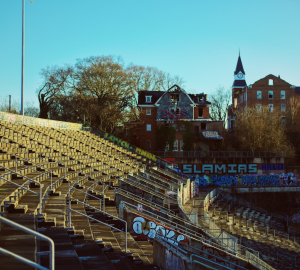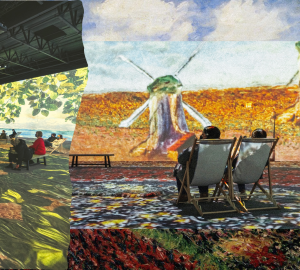Dissecting life and art. The creation of “Patchwork”: A solo exhibition by Krista M. Jones
This article was submitted by a contributing writer. To submit your own work for The Connector, email features@scadconnector.com.

“Dissecting life and art. The creation of “Patchwork”: A solo exhibition by Krista M. Jones” by Maria Gonzales
Krista M. Jones, also known as JONESY in the Atlanta street art and mural world, will host the opening of her solo exhibition “Patchwork” on May 6. This is her first solo exhibition in twenty years, and it will debut a new body of figurative abstract paintings.
This exhibit is a culmination of years of processing her human existence and her experience through the world. She calls herself a symbolist, using non-human figuration in most of her art to work through human issues. For example, avian themes can be seen often, where unusual birds and nest-like shapes act as symbols for themes focusing on freedom and the cycle of life. She explains that a lot of it is her processing her own humanness and exploring this through different viewpoints.
Jones was approached about the exhibition while feeling stuck during the pandemic. During this time, she was feeling disconnected from the community and was trying to figure out a way to reconnect, not just with herself and her work, but with other people. She felt that she had to make some serious changes in the way she was approaching her work. The idea of creating complexity poses challenges. However, she claims as an artist she is more a problem solver than a creative–she creates puzzles for herself to figure out how they work. This body of work is a great example of that process of creation.
What makes Jones’ studio work unique and inspiring is that she often paints new pieces on top of previous works of art. Jones started doing this years ago out of necessity, due to the lack of resources. She’s found that although she can afford new canvases today, there’s something cathartic about utilizing previous work and figuring out how to give it new life. She believes that this technique embeds more intention and energy into the works. She will sometimes create a painting, just to cover it with the final image. This seems to give her art deeper meaning as the new forms that take shape, sometimes revealing glimpses of the existing painting underneath. It also creates layers, texture and visual depth that wouldn’t be there otherwise. Jones occasionally uses materials such as collaged paper to gain texture on the canvas. In a way, it’s also symbolic of Jones’ personal journey.
As mentioned previously, Jones signs her studio work as “K.Jones” and uses “JONESY” when she is working on murals. Back in 2008 she spent time selling her art on the street in Little Five Points, creating paintings on found objects and other materials she had access to. “Back then,” she explains, “I was struggling with a serious heroin addiction, nearly homeless and while creating art to make money would sign everything as ‘JONESY’.”
However, her life is much different now. Jones is very open about her journey and longtime recovery. She believes transparency is vital to helping others and thriving on the other side of addiction. She finds using the name she was known by back then is empowering and important. Even after all these years, past art collectors have reached out to her as she resurfaced in Atlanta. They found her because of the old nickname and shared that they still had her work from 2007 to 2009, when her artwork was mostly little monsters on scrap wood. She smiles and laughs as she says, “I had no idea my little monsters were creating joy back then and my art made any impact on others. My work doesn’t look like that anymore, but guess I still create monsters in a different way.” For Jones, it is important for her to remember those challenging years and to own that nickname.
Problem-solving and the world around Jones have inspired her more than anything with this collection. She has not only worked on large-scale works but has also explored sculpture, and installation work which has given her new ways to problem-solve. She had been wanting to create an installation based on some lattice-like stick shapes elements found in her paintings. These shapes were inspired by huge ivy vines that wrapped around an oak tree outside her studio window. She had severed the roots of the vine years prior and was waiting for the day they would finally drop, which took about four years. She had been thinking of ways to recreate those pieces to incorporate them into installation work for her exhibit but had been losing hope to get it done in time.
Finally, days prior to this interview, a huge chunk of the woven vine fell off the tree on its own. She is now cleaning them and will have them in time for the exhibit. Jones shared that she feels one thing leads to another in life and all experiences are interconnected. This timely example of that will allow her to create a more expansive experience so people can see what inspires some of this work.
This collection starts with a painting called “Into the Void” and grows into a series of complex large-scale works. These paintings use color and fragments of identifiable forms to provide the viewer a little glimpse of possible subject matter. Jones does not tell the audience what this work is but wants them to explore and interpret it based on their own experience. Everything she uses in her art is based on symbolism. Including avian themes because there is a sense of awe in the way a bird can freely move about in flight, which Jones wants to capture in her work.
Jones predominantly uses acrylic in her paintings because of the fast dry time. It creates an intentional challenge for the artist and allows her to push what the medium can do. It provides a space where she can create the illusion of something painted in oil while not using anything to make the dry time slower. A soft relief sculpture will be featured in her collection that is specifically made to provide a tactile interpretation of some of the shapes and colors that viewers might see in the background of her paintings. It was built on canvas so there is a hidden painting in the sculpture and is framed in a floating frame. It is on display for attendees to gently touch.
Visually the sculpture also has a patchwork so this can be appreciated by both sighted and visually impaired visitors. In thinking of avian themes, aerial landscapes and the world from above looking down, you see a patchwork. From traveling a lot, Jones holds this point of view from her personal journey. In this patchwork, Jones is patching together all the different styles and techniques that she has appreciated over the years by merging them into this body of work. She gathers inspiration from cubism in creating confusion between where the foreground and background lie.
The sculpture pieces in this collection are cohesive with the exhibit. Between the paintings, however, the tones change as Jones’ life was hit with different things while taking the time to create this body of work. There are glimpses of herself in this collection as her work is about processing her own life experiences. Because of this, the work expresses both light and dark sides of the human experience. There are a few paintings that when you sit with them some darkness can be felt within them. Jones finds it interesting and unexpected as people have been responding to these pieces with positive emotions. It made her realize how important it is as artists to push ourselves a little further. Especially as visual artists, we must step outside of something that others know us for to grow. Jones felt the need to reframe that and not worry about how others would perceive it. Jones expects physical and emotional responses to her work. It doesn’t have to mean something specific, as long as she creates a feeling.
Jones decided to create an entirely new body of work specifically for this exhibit which gave her the room to be flexible to grow and try new things.

The Hudgens Center for Art & Learning is striving to incorporate a more accessible experience for the visually impaired in its exhibitions. Braille descriptions will be featured along with audio descriptions written and recorded by the artist. At first, Jones found the audio descriptions to be a challenge because of her intention for the viewer to take away what they want from the art, but she framed it as an exciting new puzzle to solve. Jones focused on describing the art in a matter-of-fact way with the use of similes to describe color, texture and shape. She cited explanations in a concise way that would allow the listener to visualize the descriptions. It’s the first attempt for both the Center and Jones to help make visual art more accessible. The soft relief sculpture in this collection adds tactile elements for attendees to explore texture and shape.
Keep up with Jones through Facebook and Instagram @JONESYARTATL, and her website jonesyartatl.com as well. “Patchwork” will have a public opening reception, May 6 from 2:00 – 4:00 pm where Jones will also be present. “Patchwork” will be on view at the Hudgens Center for Art & Learning from May 6 to July 22 in Duluth, Georgia at Building 300, 6400 Sugarloaf Pkwy, Duluth, GA 30097.


























